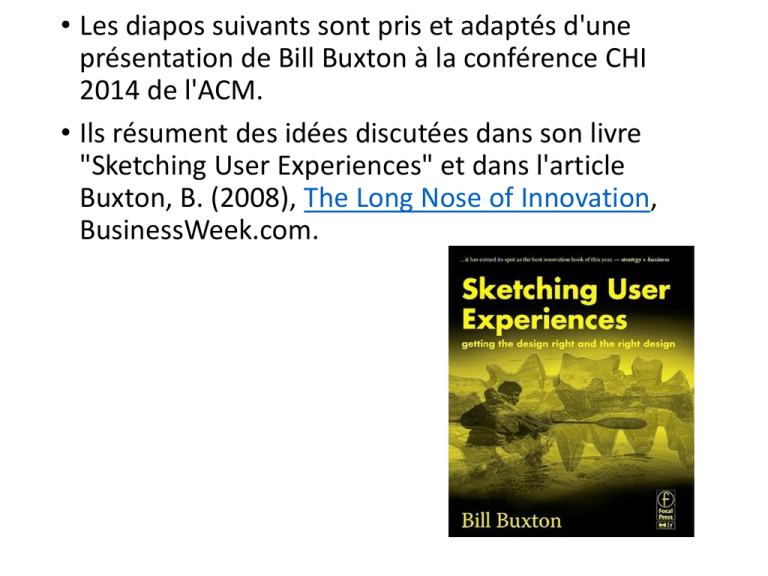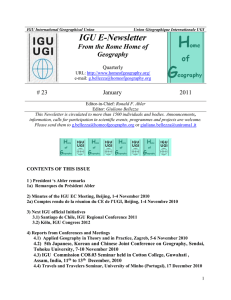The Long Nose of Innovation
advertisement

• Les diapos suivants sont pris et adaptés d'une présentation de Bill Buxton à la conférence CHI 2014 de l'ACM. • Ils résument des idées discutées dans son livre "Sketching User Experiences" et dans l'article Buxton, B. (2008), The Long Nose of Innovation, BusinessWeek.com. The Long Nose of Innovation New technology Radar ≈20-30 years $1B • Arguably, the original bondiblue iMac saved Apple • It is useful to remember that behind the skin, in the OS, applications, and processor, it was the same as what preceded it. Power Macintosh G3 All-in-one iMac Introduced: March 1998 Terminated: September 1998 Introduced: August 1998 Terminated: January 1999 Processor CPU: PowerPC 750 "G3" CPU Speed: 233/266 MHz Processor CPU: PowerPC 750 "G3" CPU Speed: 233 MHz More detailed view showing OS releases. Mac OS 8 The Long Nose of the iPod • Christmas 2004 could be called “iPod Christmas” • Seemingly out of nowhere (for many), the iPod became the “must have” gift • Released in July that year, it stormed the marketplace • But was it really “out of nowhere”? • No. It was actually the 4th generation of a product that had just hit the “tipping point” • Up to then, it had just been following the Long Nose, below the radar. July 2004 G1: October 2001 G2: July 2002 G3: April 2003 G4: July 2004 Observation 1: It took 3 ¾ years and 4 generations for the iPod to become an “overnight” success. Observation 2: Each generation tinkered with one of its most iconic features: the scroll wheel. Precedents Questions around the nature of innovation, originality, and design. What about a portable music player on which you can listen through headphones as you move around? Regency TR-1 Transistor Radio (1954) • World’s first commercially available transistor radio. • Designed by Painter, Teague and Peterfil What about a portable music player on which you can store your own music? Sony TPS-L2 Walkman (1978) • Used audio cassette technology • Introduced 1978 What about one that uses random access digital MP3 files rather than analogue, sequential audio cassettes? Elger Labs MPMan F10 (1998) • First portable music player using MP3 files • Stored music in flash memory, enabling random access • $250 • 32MB of memory • could hold eight 4-minute songs. • could upgrade the memory to 64MB by sending the unit back to Eiger labs with a check for $69 plus $7.95 shipping. What about one that stores the MP3 files on a miniature hard drive, thereby increasing amount of music that you can store? HanGo / Remote Solution Personal Jukebox PJB-100 (2000) • First hard-disk based portable MP3 Player • The original design was developed by Compaq starting in May 1998. • Compaq licensed the design to HanGo Electronics • Had 4.8GB vs the 32/64MB storage found on flash memory players of the time • Upped storage to over 1,000 songs. • Original price: $799. USD What about roots of the form-factor / industrial design? Typically, ideas do not advance in a single step; rather, in a linked chain of steps, each link building on the tradition of those preceding. Above are 3 steps in such a progression. To me, a core part of design competence is the skill to search for, find, and appreciate such chains. Apple G4 iPod, July 2004 Regency TR-1 Transistor Radio, 1954 Braun T3 Transistor Radio, 1958 Recognizing a design as such a link is far more interesting and Jonathan Ive Painter, Teague and Peterfil Dieter Rams informative than thinking about it as the result of some divine creative flash of genius, and thus coming out of nowhere. For the aspiring designer, this is also a relief, since I don’t know anyone who can teach divine inspiration; however I do know that anyone can learn to mine the world for great traditions worthy of building upon. Impact on Apple Products? Apple iMac G5 (2004) • Released August 2004, one month after the G4 iPod • Adopts iPod design language This was stunning brilliance. Apple had been selling computers since 1977, and here they just flipped the whole thing around, redefined their identity. This campaign signaled that Apple was no longer a computer company, something that was formalized 3 years later. To put it in context …. To Start: Just Apple 1977 1978 1979 1980 1981 1982 1983 1984 1985 1986 1987 1988 1989 1990 199130 1992 1993 1994 1995 1996 1997 1998 1999 2000 2001 2002 2003 2004 2005 2006 2007 Years June 10, 1977 Apple ][ Computer Released January 3, 1977 Incorporated as Apple Computer October, 2001 G1 iPod Released July, 2004 G4 iPod Released August, 2004 iMac G5 Released January 9, 2007 Name changed to Apple Inc. The Bigger Picture 1950 1960 1970 The Long Nose1980 – 50+ years 1990 2000 Elgar MPman, 1998 Personal Jukebox, 2000 Sony TPS-L2 Walkman, 1978 G1 iPod, 2001 Braun T3, 1958 Regency TR-1, 1954 Apple ][ Computer June, 1977 Apple Computer Incorporated Jan. 1977 G4 iPod, 2004 iMac G5, 2004 Name changed to Apple Inc. Jan. 2007 Another quick example, just to be sure that the above is a pattern, not an exception. • In 1926, Kodak launched this black camera. • It was successful • However, it was selling mainly to men • They wanted to extend the market • So they engaged Walter Dorwin Teague to design a model that would appeal to women • His solution was to release a version of the camera in 5 different colours, each packed in a pseudo-silk lined box, where the box and liner matched the colour of the camera Kodak Vest Pocket Series III (1926) Walter Dowrin Teague Vanity Kodak (1928) In 2001 launched this white iPod. It was successful However, it was selling more to men They wanted to extend the market So they designed a model that would better appeal to women • Their solution was to release a smaller version of the iPod in 5 different colours. • • • • • Apple G1 iPod, October 2001 Jonathan Ive Apple iPod Mini (2004) Walter Dowrin Teague Vanity Kodak (1928) • • • • • • Same basic design brief Same use of colour as part of the solution Same choice of base colours Same number of colours Same simultaneous release Coincidence? Observations • The Teague/Kodak example is a classic • It would be known to virtually any trained industrial designer • Jonathan Ive is nothing, if not an extremely well trained industrial designer, whose work shows a high level of fluency in the history of his craft. • In his solution, he was doing what any competent designer would do: draw inspiration from the past. • Rather than diminish respect for his solution, his choice of what to draw on, and how to shape it to his design brief, is cause to augment respect for his work. The Long Nose of Innovation $1B 2007 iPhone Launch 1984 Capacitive Multi-touch Radar >20 years The Edison Myth of the lone genius inventor • If Edison invented all that he is credited for, what were all those people doing in his labs? • Edison was the Steve Jobs of his era • Actually, that should be the other way around. • As one of the first US businessmen to hire a press agent to create his own myth, he created the model for Jobs. • The key take-away is this: in buying into the Edison Myth, one sets a bar that not even Edison (or Jobs) could achieve. • So what hope have you or me? Un autre exemple • 1965: souris inventée par William English et Doug Engelbart • 1968: copiée par le National Research Council de Canada • 1973: copiée par Xerox PARC pour le Alto computer • 1980: 3 Rivers Systems offre le PERQ-1 workstation, la première station de travail commerciale avec souris • 1981: Xerox Star 8010 workstation • 1984: le premier Macintosh de Apple • 1995: Microsoft Windows 95 (la souris est maintenant répandue) • Délai de 30 ans! • (pour plus de détails, voir Buxton, B. (2008), The Long Nose of Innovation, BusinessWeek.com) … from a very old idea Petitbled roller blade. Patented 1819. Example: A recent commercial success .… Seiko Watch TV (1982) Not quite a fair comparison, but still …. • 32 year interval • 21 doubling periods of Moore’s Law (21×1.5 years) • Factor of 2,000,000 increase in computing power • Same paired architecture • But we got rid of the wires Samsung Galaxy Gear (2014) Et donc? • Les technologies prennent longtemps avant de maturer • Les meilleures innovations sont des améliorations d'anciennes idées • La meilleure façon d'identifier des innovations intéressantes est d'explorer beaucoup d'idées rapidement (avant une connaissance de ce qui a été fait avant) • Pour faire cela, il faut avoir l'habitude d'observer et de noter les bons et mauvais exemples de design autour de nous, et de faire beaucoup de croquis ("sketches") Sketches Attributes of a Sketch Quick Timely Inexpensive Disposable Plentiful Clear vocabulary Minimal Detail Appropriate Degree of Refinement Suggest & explore rather than confirm Ambiguity Examples of reference material … e-bay is one great place to prospect for samples that can serve as experiential sketches. SIGCHI 2011 My collection.… In light of the huge interest in the maker’s movement, to maintain balance, I think it important to understand that e-bay (a sampling tool) may be at least as important as, for example 3D printing, or Arduino (synthesis tools), in sketching experience. Résumé • Habituellement, la créativité et l'innovation ne viennent pas d'une seule inspiration d'un génie. L'innovation est un processus d'améliorations incrementales qui, suite à beaucoup d'essais et de tentatives, peuvent finalement donner un grand succès. (Buxton parle du "long nez" de l'innovation, prenant 20-30 ans avant qu'une nouvelle technologie soit un grand succès.) • Même les "grands", comme Steve Jobs et Thomas Edison, ont seulement réussi grâce à beaucoup d'essais et d'erreurs par de grandes équipes d'employés qui ont amélioré des idées déjà existantes. Donc, ne vous attendez pas à tomber sur la bonne solution du premier coup, ni de tomber sur une solution complètement originale. Vous devez générer beaucoup d'idées et de solutions potentielles (en vous inspirant d'anciennes idées), et les retravailler en parallèle, avant de pouvoir juger de la meilleure à poursuivre en développement. • Les croquis (sketches) rapides sont une excellente façon d'explorer beaucoup d'idées rapidement. Les prototypes devraient venir plus tard. • Ne sous-estimez pas l'importance du design industriel et le design graphique, ce que Buxton appelle le "styling".







